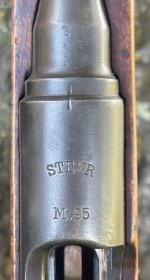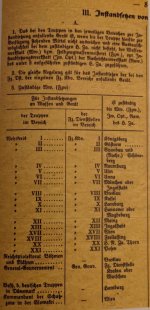Fair warning! I want to use you guys as a sounding board for an approach I’d like to try. I usually post new acquisitions with photos and a description, but not much else. I want to test out what you could describe as a ‘360 degree’ approach. My goal is to situate and contextualize the featured items in their own historical setting, and blend them into a micro and macro historical presentation of physical items, eye witness accounts, historical documents, and photographic evidence. Let me know what you think.
M.95 Mannlicher Stutzenkarabiner
I was fortunate to acquire this depot stamped M.95 Mannlicher recently, which has some very attractive features. It is still chambered in 8X50R and is all matching. There are no indications of re-numbering or replacement of parts.
Three aspects of this carbine are of particular interest. It has a uniquely Hungarian front sight protector, a type otherwise only seen on 31M short rifles that went through the same chamber modifications to 8X56R as the Mannlichers that remained in Austrian possession after 1919. There is a stamp on the right side of the stock near the receiver which I’ve never seen in the flesh. The only example I’ve ever seen is on Manowar’s Hungarian small arms website, and even then it’s shown without attribution or context at the end of the 35M rifle section. I’ve asked around but apparently haven’t yet found the answer I’m looking for. Finally, there is an HZa depot stamp from Wels, Austria on the right side butt stock. Awhile back I was able to locate an Austro-Hungarian M.1890 Extra Corps Gewehr (see here: https://www.k98kforum.com/threads/hza-stamped-austro-hungarian-model-1890-extra-corps-gewehr.34667/ ) with the same stamp.
Foreign captured Mannlichers and the German depots
While not unheard of, it’s very uncommon for two Mannlicher carbines (still in Austria) to retain their 8X50R chambering. My M.1890 was very likely captured in the Kingdom of Yugoslavia following the German invasion of April 1941. Yugoslavia retained many of thousands of Mannlichers that weren’t converted to the M.95M standard in the 1930s, and this was probably one of them. Even though Mannlichers originated in the Austro-Hungarian Empire (Steyr and Budapest), it’s likely that German forces who captured these felt the need to confirm caliber and determine what if any modifications might have been made, necessitating examination by qualified armorers and Ordnance personnel at the depots. At that point, it’s likely they would have received the depot stamp.
Wels: Background and Wartime Role
Wels lies in the Oberdonau region of (upper) Austria. After the Anschluss, Wels became the location for Infantry and Artillery units of the Wehrmacht’s Ersatzheer, providing a training ground and recruiting area for Wehrkreis XVII. Located at a railway junction, it had an airport, aerodrome and aircraft factory nearby. Operating under the parent company of Fichtel and Sachs, Rotax-Werk AG produced ball bearings and engines in Wels. Not surprisingly, it became an area of interest in the Allied bombing campaign.
According to unit records, it appears that the 450th and 459th Bomber Groups were assigned responsibility for destroying the Wehrmacht’s capacity to produce war materiel at Wels. The details of these raids are confirmed in the USAAF Worldwide Operations Chronology. Starting in early 1944, Wels would be bombed into March 1945, with marshalling yards and ordnance factories noted as the focus of operations. During one raid on 20 March 1945, a young American pilot developed engine trouble in his P-51C Mustang and had to bail out over Wels. He landed unharmed and was taken prisoner. His unit would go on to receive post-war accolades, its members forming a part of what later emerged as the Civil Rights Movement in the USA. Young 1LT. Newman Camay Golden, a Tuskegee Airman, was later liberated and would remain in the USAAF as it transitioned into the USAF. Golden answered the call once again in 1951. On 17 October 1951, Golden was flying a P-51D night fighter with the 39th Fighter Interceptor Squadron, 18th Fighter Bomber Group in the vicinity of Choso-ri, Korea. On that date, Golden’s aircraft received a direct hit from AA fire, subsequently crashing and bursting into flames. First listed as MIA, Golden would be declared KIA on 31 March 1954.
Wels and the Holocaust
A darker chapter of Germany’s wartime armaments production would be played out in Wels, as it had in numerous other locations in Austria. It became the site of two of Mathausen’s sub-camps, Wels I (Gunskirchen-Wels) and Wels II (Ebensee-Wels). Consisting partly of underground facilities, the two camps combined to produce aircraft, armaments and metal construction.
More forced labor arrived in the form of Hungarian Jews that had been sent west following both the closure of Auschwitz-Birkenau (to which many Hungarian Jews had been sent or had been slated to be sent), and the seizure of Budapest by the Soviet Army. Arriving in Wels, the Jews had survived a little known death march, the only ‘respite’ being their assignment to dig hasty tank trenches and defenses in western Hungary and eastern Austria in an attempt to slow the Soviet advance. They had arrived in April 1945 and joined the ranks of slave laborers already assigned to work in Wels’ factories.
Wels’ wartime role came to an end on 4 May 1945, when lead elements of the US 71st Cavalry Reconnaissance Troop located and engaged a German convoy between Wels and Lambach. Proceeding forward, they also located numerous buildings inside a securely fenced enclosure. They were greeted by the surviving Jews and slave laborers, who soon revealed the nature of the facility and the wider reality of the Holocaust. The 71st scrambled to bring together as much food as possible, emptying their ‘C’ and ‘K’ rations for the prisoners. In short order, the 60th US Field Hospital erected and put five temporary hospitals into operation, attending to the liberated prisoners and the c.2,500 surviving Hungarian Jews.
Final thoughts
Although the foreign weapons inspection role of the Wels depot was dwarfed by aircraft and armaments production nearby, it still holds the attention of collectors. I haven’t seen ex-depot Mannlichers stamped by any other facility, and it is also known for marking Mannlicher M.95 bayonets and even some K98k depot build rifles. It’s possible that the fact that those Mannlichers had an Austrian origin played some role in their being stored in Austria. Once could also surmise that there were experienced armorers still alive at that time in Austria, along with Mannlicher-specific tools and spare parts. In any case, it begs the question of if and how those carbines were used after processing through the depot.
If any of you have seen or know of the circular marking I drew attention to, I'd love to hear about it. I do wonder if there is any kind of a Hungarian connection to it at all. It's anyone's guess how the 31M front sight protector wound up on this rifle. These are very difficult to locate, so it's not really something that a collector pulls off of a 31M and throws on to another rifle.
M.95 Mannlicher Stutzenkarabiner
I was fortunate to acquire this depot stamped M.95 Mannlicher recently, which has some very attractive features. It is still chambered in 8X50R and is all matching. There are no indications of re-numbering or replacement of parts.
Three aspects of this carbine are of particular interest. It has a uniquely Hungarian front sight protector, a type otherwise only seen on 31M short rifles that went through the same chamber modifications to 8X56R as the Mannlichers that remained in Austrian possession after 1919. There is a stamp on the right side of the stock near the receiver which I’ve never seen in the flesh. The only example I’ve ever seen is on Manowar’s Hungarian small arms website, and even then it’s shown without attribution or context at the end of the 35M rifle section. I’ve asked around but apparently haven’t yet found the answer I’m looking for. Finally, there is an HZa depot stamp from Wels, Austria on the right side butt stock. Awhile back I was able to locate an Austro-Hungarian M.1890 Extra Corps Gewehr (see here: https://www.k98kforum.com/threads/hza-stamped-austro-hungarian-model-1890-extra-corps-gewehr.34667/ ) with the same stamp.
Foreign captured Mannlichers and the German depots
While not unheard of, it’s very uncommon for two Mannlicher carbines (still in Austria) to retain their 8X50R chambering. My M.1890 was very likely captured in the Kingdom of Yugoslavia following the German invasion of April 1941. Yugoslavia retained many of thousands of Mannlichers that weren’t converted to the M.95M standard in the 1930s, and this was probably one of them. Even though Mannlichers originated in the Austro-Hungarian Empire (Steyr and Budapest), it’s likely that German forces who captured these felt the need to confirm caliber and determine what if any modifications might have been made, necessitating examination by qualified armorers and Ordnance personnel at the depots. At that point, it’s likely they would have received the depot stamp.
Wels: Background and Wartime Role
Wels lies in the Oberdonau region of (upper) Austria. After the Anschluss, Wels became the location for Infantry and Artillery units of the Wehrmacht’s Ersatzheer, providing a training ground and recruiting area for Wehrkreis XVII. Located at a railway junction, it had an airport, aerodrome and aircraft factory nearby. Operating under the parent company of Fichtel and Sachs, Rotax-Werk AG produced ball bearings and engines in Wels. Not surprisingly, it became an area of interest in the Allied bombing campaign.
According to unit records, it appears that the 450th and 459th Bomber Groups were assigned responsibility for destroying the Wehrmacht’s capacity to produce war materiel at Wels. The details of these raids are confirmed in the USAAF Worldwide Operations Chronology. Starting in early 1944, Wels would be bombed into March 1945, with marshalling yards and ordnance factories noted as the focus of operations. During one raid on 20 March 1945, a young American pilot developed engine trouble in his P-51C Mustang and had to bail out over Wels. He landed unharmed and was taken prisoner. His unit would go on to receive post-war accolades, its members forming a part of what later emerged as the Civil Rights Movement in the USA. Young 1LT. Newman Camay Golden, a Tuskegee Airman, was later liberated and would remain in the USAAF as it transitioned into the USAF. Golden answered the call once again in 1951. On 17 October 1951, Golden was flying a P-51D night fighter with the 39th Fighter Interceptor Squadron, 18th Fighter Bomber Group in the vicinity of Choso-ri, Korea. On that date, Golden’s aircraft received a direct hit from AA fire, subsequently crashing and bursting into flames. First listed as MIA, Golden would be declared KIA on 31 March 1954.
Wels and the Holocaust
A darker chapter of Germany’s wartime armaments production would be played out in Wels, as it had in numerous other locations in Austria. It became the site of two of Mathausen’s sub-camps, Wels I (Gunskirchen-Wels) and Wels II (Ebensee-Wels). Consisting partly of underground facilities, the two camps combined to produce aircraft, armaments and metal construction.
More forced labor arrived in the form of Hungarian Jews that had been sent west following both the closure of Auschwitz-Birkenau (to which many Hungarian Jews had been sent or had been slated to be sent), and the seizure of Budapest by the Soviet Army. Arriving in Wels, the Jews had survived a little known death march, the only ‘respite’ being their assignment to dig hasty tank trenches and defenses in western Hungary and eastern Austria in an attempt to slow the Soviet advance. They had arrived in April 1945 and joined the ranks of slave laborers already assigned to work in Wels’ factories.
Wels’ wartime role came to an end on 4 May 1945, when lead elements of the US 71st Cavalry Reconnaissance Troop located and engaged a German convoy between Wels and Lambach. Proceeding forward, they also located numerous buildings inside a securely fenced enclosure. They were greeted by the surviving Jews and slave laborers, who soon revealed the nature of the facility and the wider reality of the Holocaust. The 71st scrambled to bring together as much food as possible, emptying their ‘C’ and ‘K’ rations for the prisoners. In short order, the 60th US Field Hospital erected and put five temporary hospitals into operation, attending to the liberated prisoners and the c.2,500 surviving Hungarian Jews.
Final thoughts
Although the foreign weapons inspection role of the Wels depot was dwarfed by aircraft and armaments production nearby, it still holds the attention of collectors. I haven’t seen ex-depot Mannlichers stamped by any other facility, and it is also known for marking Mannlicher M.95 bayonets and even some K98k depot build rifles. It’s possible that the fact that those Mannlichers had an Austrian origin played some role in their being stored in Austria. Once could also surmise that there were experienced armorers still alive at that time in Austria, along with Mannlicher-specific tools and spare parts. In any case, it begs the question of if and how those carbines were used after processing through the depot.
If any of you have seen or know of the circular marking I drew attention to, I'd love to hear about it. I do wonder if there is any kind of a Hungarian connection to it at all. It's anyone's guess how the 31M front sight protector wound up on this rifle. These are very difficult to locate, so it's not really something that a collector pulls off of a 31M and throws on to another rifle.
Attachments
Last edited:




















